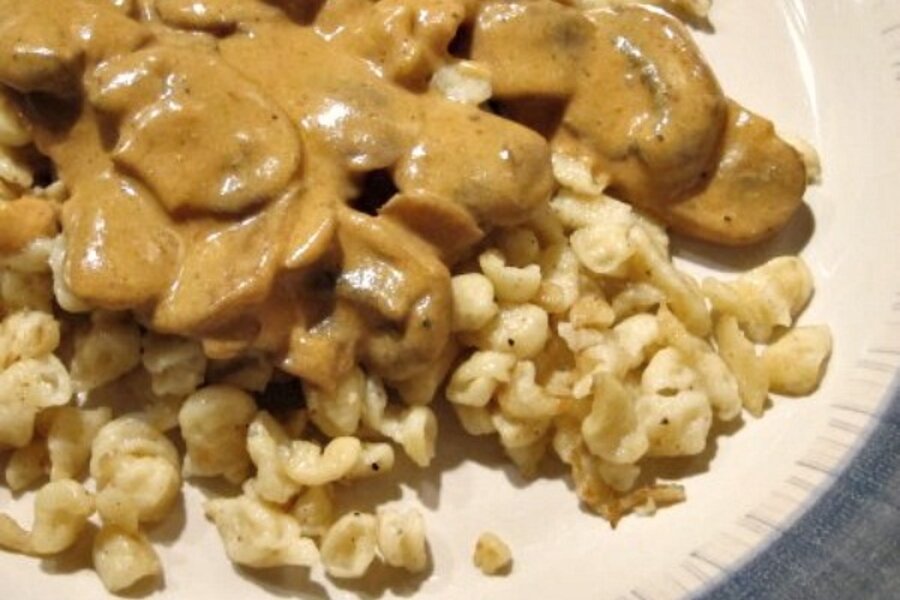Meatless Monday: How to make spaetzle
Loading...
Making homemade spaetzle is not particularly difficult and well worth a small investment of time. The irregular little dumplings are also called "little sparrows," as they are shaped somewhat like a little bird, with a pointy end resembling a beak, from where the dough drops into boiling water to cook. They are excellent served simply with browned butter, salt and pepper, but also serve as an ideal stand in for rice or pasta as a base for a sauce.
I’ve had a spaetzle maker languishing in my pantry for months, after I bought it online in a burst of enthusiasm, then got distracted by other projects. I normally resist kitchen gadgets – particularly the single use variety – but the spaetzle maker was only about $10, and well worth every penny.
With the new year, my interest in spaetzle was renewed, partly by a visit to a new German restaurant in town.
There are a lot of spaetzle recipes out there, all generally a combination of eggs, flour, and liquid. The best recipe is probably the one your grandmother used, should you be lucky enough to have a grandmother who made spaetzle. If not, this recipe makes consistently lightly chewy "little sparrows" that are good enough to eat straight out of the bowl with your fingers.
The key thing is to get the thickness of the batter right, which means adjusting the amount of water you use judiciously, as flour can vary quite a bit in moisture content. After resting in the refrigerator, it should be shiny smooth and thicker than pancake batter but thinner than frosting, a little stretchy but still fluid enough to plop off a spoon.
If you happen to have a colander with unusually large holes (about 1/4 inch) you can use it to make the spaetzle, forcing the batter through the holes with a rubber scraper into boiling water. But the spaetzle maker is ridiculously easy to use. It even has a lip that holds it securely on top of a stockpot full of boiling water while you fill the little hopper on top with a big glop of the batter and slide it back and forth on top of the perforated base. Little dollops of batter will drop into the boiling water, magically right-sized.
Once browned in butter, the spaetzle becomes something spectacular, with a bit more chewiness and delightfully crispy little edges here and there. We served ours with this rich and delicious mushroom stroganoff on top.
Spaetzle
Adapted from The Zuni Cafe Cookbook
Makes about 2.5 cups
1-1/2 cups all purpose flour
1/2 teaspoon salt
Dash nutmeg
2 large eggs
8-10 tablespoons lukewarm water
1 tablespoon olive oil
In a large bowl, stir together flour, salt, and nutmeg. Crack the eggs into a separate bowl; beat lightly with a fork. Pour the eggs over the flour and stir with the fork just until the eggs are absorbed, about 10 strokes. Don’t worry that most of the flour is still dry and loose. Stir in 6 tablespoons of the water, to make a heavy, lumpy batter. Trickle in the remaining water, stopping once the batter is soft and no longer holds a peak as you mix it.
Lift the fork clad with some of the batter; it should hang for a second before dropping. As it rests, the batter will smooth out and begin to look like warm taffy. Cover and let batter rest in the refrigerator for at least an hour, several hours or overnight is okay too.
Fill a stockpot with water, salt liberally, add the oil. Bring water to a boil.
Spoon about half of the batter into the spaetzle maker (or a colander with 1/4-inch wide holes), and set it over the boiling water, resting it on the edge of the pan. Press the batter through the holes. They will initially sink, but they will swell and float within 30 seconds as they fill with steam. Stop adding batter once the surface of the water becomes crowded.
Let the spaetzle cook for about 1 minute after they float. Lift them out with a skimmer or strainer, shake gently to drain, and tip them into a bowl of ice water to stop the cooking. Repeat with the rest of the batter.
Only use as much batter as you can press through in 15 seconds or less, and never add more batter than the surface of the water can safely harbor.
At this point the spaetzle can be drained and refrigerated for up to a few days. When ready to use, heat 2 tablespoons butter in a large skillet, and cook spaetzle, turning occasionally, until golden brown and a little crispy in places. Sprinkle with salt and pepper.
Related post: Spaghetti Bolognese






